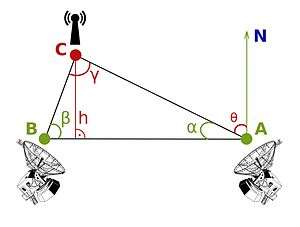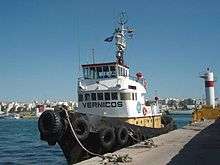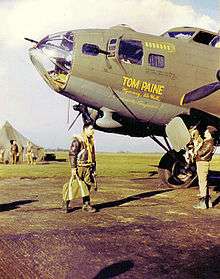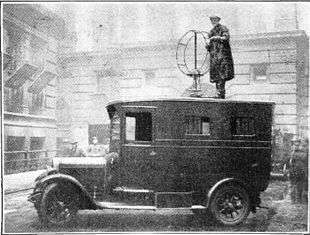Direction finding
Direction finding (DF), or radio direction finding (RDF), is the measurement of the direction from which a received signal was transmitted. This can refer to radio or other forms of wireless communication, including radar signals detection and monitoring (ELINT/ESM). By combining the direction information from two or more suitably spaced receivers (or a single mobile receiver), the source of a transmission may be located via triangulation. Radio direction finding is used in the navigation of ships and aircraft, to locate emergency transmitters for search and rescue, for tracking wildlife, and to locate illegal or interfering transmitters. RDF was important in combating German threats during both the World War II Battle of Britain and the long running Battle of the Atlantic. In the former, the Air Ministry also used RDF to locate its own fighter groups and vector them to detected German raids.


RDF systems can be used with any radio source, although very long wavelengths (low frequencies) require very large antennas, and are generally used only on ground-based systems. These wavelengths are nevertheless used for marine radio navigation as they can travel very long distances "over the horizon", which is valuable for ships when the line-of-sight may be only a few tens of kilometres. For aerial use, where the horizon may extend to hundreds of kilometres, higher frequencies can be used, allowing the use of much smaller antennas. An automatic direction finder, which could be tuned to radio beacons called non-directional beacons or commercial AM radio broadcasters, was until recently, a feature of most aircraft, but is now being phased out [1]
For the military, RDF is a key tool of signals intelligence. The ability to locate the position of an enemy transmitter has been invaluable since World War I, and played a key role in World War II's Battle of the Atlantic. It is estimated that the UK's advanced "huff-duff" systems were directly or indirectly responsible for 24% of all U-Boats sunk during the war. Modern systems often used phased array antennas to allow rapid beamforming for highly accurate results, and are part of a larger electronic warfare suite.
Early radio direction finders used mechanically rotated antennas that compared signal strengths, and several electronic versions of the same concept followed. Modern systems use the comparison of phase or doppler techniques which are generally simpler to automate. Early British radar sets were referred to as RDF, which is often stated was a deception. In fact, the Chain Home systems used large RDF receivers to determine directions. Later radar systems generally used a single antenna for broadcast and reception, and determined direction from the direction the antenna was facing.[2]
Antennas
Direction finding requires an antenna that is directional (more sensitive in certain directions than in others). Many antenna designs exhibit this property. For example, a Yagi antenna has quite pronounced directionality, so the source of a transmission can be determined simply by pointing it in the direction where the maximum signal level is obtained. However, to establish direction to great accuracy requires more sophisticated technique.

A simple form of directional antenna is the loop aerial. This consists of an open loop of wire on an insulating former, or a metal ring that forms the antenna elements itself, where the diameter of the loop is a tenth of a wavelength or smaller at the target frequency. Such an antenna will be least sensitive to signals that are normal to its face and most responsive to those meeting edge-on. This is caused by the phase output of the transmitting beacon. The phase changing phase causes a difference between the voltages induced on either side of the loop at any instant. Turning the loop face on will not induce any current flow. Simply turning the antenna to obtain minimum signal will establish two possible directions from which the signal could be emanating. The NULL is used, as small angular deflections of the loop aerial near its null positions produce larger changes in current than similar angular changes near the loops max positions. For this reason, a null position of the loop aerial is used.
To resolve the two direction possibilities, a sense antenna is used, the sense aerial has no directional properties but has the same sensitivity as the loop aerial. By adding the steady signal from the sense aerial to the alternating signal from the loop signal as it rotates, there is now only one position as the loop rotates 360° at which there is zero current. This acts as a phase ref point, allowing the correct null point to be identified, thus removing the 180° ambiguity. A dipole antenna exhibits similar properties, and is the basis for the Yagi antenna, which is familiar as the common VHF or UHF television aerial. For much higher frequencies still, parabolic antennas can be used, which are highly directional, focusing received signals from a very narrow angle to a receiving element at the centre.
More sophisticated techniques such as phased arrays are generally used for highly accurate direction finding systems called goniometers such as are used in signals intelligence (SIGINT). A helicopter based DF system was designed by ESL Incorporated for the U.S. Government as early as 1972.

Single-channel DF
Single-channel DF uses a multi-antenna array with a single channel radio receiver. This approach to DF offers some advantages and drawbacks. Since it only uses one receiver, mobility and lower power consumption are benefits. Without the ability to look at each antenna simultaneously (which would be the case if one were to use multiple receivers, also known as N-channel DF) more complex operations need to occur at the antenna in order to present the signal to the receiver.
The two main categories that a single channel DF algorithm falls into are amplitude comparison and phase comparison. Some algorithms can be hybrids of the two.
Pseudo-doppler DF technique
The pseudo-doppler technique is a phase based DF method that produces a bearing estimate on the received signal by measuring the doppler shift induced on the signal by sampling around the elements of a circular array. The original method used a single antenna that physically moved in a circle but the modern approach uses a multi-antenna circular array with each antenna sampled in succession.
Watson-Watt, or Adcock-antenna array
The Watson-Watt technique uses two Adcock antenna pairs to perform an amplitude comparison on the incoming signal. An Adcock antenna pair is a pair of monopole or dipole antennas that takes the vector difference of the received signal at each antenna so that there is only one output from the pair of antennas. Two of these pairs are co-located but perpendicularly oriented to produce what can be referred to as the N-S (North-South) and E-W (East-West) signals that will then be passed to the receiver. In the receiver, the bearing angle can then be computed by taking the arctangent of the ratio of the N-S to E-W signal.
Correlative interferometer
The basic principle of the correlative interferometer consists in comparing the measured phase differences with the phase differences obtained for a DF antenna system of known configuration at a known wave angle (reference data set). The comparison is made for different azimuth values of the reference data set, the bearing is obtained from the data for which the correlation coefficient is at a maximum. If the direction finding antenna elements have a directional antenna pattern, then the amplitude may be included in the comparison.
Usage
Radio navigation
Radio direction finding, radio direction finder, or RDF, was once the primary aviation navigational aid. (Range and Direction Finding was the abbreviation used to describe the predecessor to radar.[2]) Beacons were used to mark "airways" intersections and to define departure and approach procedures. Since the signal transmitted contains no information about bearing or distance, these beacons are referred to as non-directional beacons, or NDB in the aviation world. Starting in the 1950s, these beacons were generally replaced by the VOR system, in which the bearing to the navigational aid is measured from the signal itself; therefore no specialized antenna with moving parts is required. Due to relatively low purchase, maintenance and calibration cost, NDB's are still used to mark locations of smaller aerodromes and important helicopter landing sites.
Similar beacons located in coastal areas are also used for maritime radio navigation, as almost every ship is (was) equipped with a direction finder (Appleyard 1988). Very few maritime radio navigation beacons remain active today (2008) as ships have abandoned navigation via RDF in favor of GPS navigation.
In the United Kingdom a radio direction finding service is available on 121.5 MHz and 243.0 MHz to aircraft pilots who are in distress or are experiencing difficulties. The service is based on a number of radio DF units located at civil and military airports and certain HM Coastguard stations.[3] These stations can obtain a "fix" of the aircraft and transmit it by radio to the pilot.
Location of illegal, secret or hostile transmitters - SIGINT

In World War II considerable effort was expended on identifying secret transmitters in the United Kingdom (UK) by direction finding. The work was undertaken by the Radio Security Service (RSS also MI8). Initially three U Adcock HF DF stations were set up in 1939 by the General Post Office. With the declaration of war, MI5 and RSS developed this into a larger network. One of the problems with providing coverage of an area the size of the UK was installing sufficient DF stations to cover the entire area to receive skywave signals reflected back from the ionised layers in the upper atmosphere. Even with the expanded network, some areas were not adequately covered and for this reason up to 1700 voluntary interceptors (radio amateurs) were recruited to detect illicit transmissions by ground wave. In addition to the fixed stations, RSS ran a fleet of mobile DF vehicles around the UK. If a transmitter was identified by the fixed DF stations or voluntary interceptors, the mobile units were sent to the area to home in on the source. The mobile units were HF Adcock systems.
By 1941 only a couple of illicit transmitters had been identified in the UK; these were German agents that had been "turned" and were transmitting under MI5 control. Many illicit transmissions had been logged emanating from German agents in occupied and neutral countries in Europe. The traffic became a valuable source of intelligence, so the control of RSS was subsequently passed to MI6 who were responsible for secret intelligence originating from outside the UK. The direction finding and interception operation increased in volume and importance until 1945.
The HF Adcock stations consisted of four 10 m vertical antennas surrounding a small wooden operators hut containing a receiver and a radio-goniometer which was adjusted to obtain the bearing. MF stations were also used which used four guyed 30 m lattice tower antennas. In 1941, RSS began experimenting with spaced loop direction finders, developed by the Marconi company and the UK National Physical Laboratories. These consisted of two parallel loops 1 to 2 m square on the ends of a rotatable 3 to 8 m beam. The angle of the beam was combined with results from a radiogoniometer to provide a bearing. The bearing obtained was considerably sharper than that obtained with the U Adcock system, but there were ambiguities which prevented the installation of 7 proposed S.L DF systems. The operator of an SL system was in a metal underground tank below the antennas. Seven underground tanks were installed, but only two SL systems were installed at Wymondham, Norfolk and Weaverthorp in Yorkshire. Problems were encountered resulting in the remaining five underground tanks being fitted with Adcock systems. The rotating SL antenna was turned by hand which meant successive measurements were a lot slower than turning the dial of a goniometer.
Another experimental spaced loop station was built near Aberdeen in 1942 for the Air Ministry with a semi-underground concrete bunker. This, too, was abandoned because of operating difficulties. By 1944, a mobile version of the spaced loop had been developed and was used by RSS in France following the D-Day invasion of Normandy.
The US military used a shore based version of the spaced loop DF in World War II called "DAB". The loops were placed at the ends of a beam, all of which was located inside a wooden hut with the electronics in a large cabinet with cathode ray tube display at the centre of the beam and everything being supported on a central axis. The beam was rotated manually by the operator.
The Royal Navy introduced a variation on the shore based HF DF stations in 1944 to track U-boats in the North Atlantic. They built groups of five DF stations, so that bearings from individual stations in the group could be combined and a mean taken. Four such groups were built in Britain at Ford End, Essex, Goonhavern, Cornwall, Anstruther and Bowermadden in the Scottish Highlands. Groups were also built in Iceland, Nova Scotia and Jamaica. The anticipated improvements were not realised but later statistical work improved the system and the Goonhavern and Ford End groups continued to be used during the Cold War. The Royal Navy also deployed direction finding equipment on ships tasked to anti-submarine warfare in order to try to locate German submarines, e.g. Captain class frigates were fitted with a medium frequency direction finding antenna (MF/DF) (the antenna was fitted in front of the bridge) and high frequency direction finding (HF/DF, "Huffduff") Type FH 4 antenna (the antenna was fitted on top of the mainmast).[4]
A comprehensive reference on World War II wireless direction finding was written by Roland Keen, who was head of the engineering department of RSS at Hanslope Park. The DF systems mentioned here are described in detail in his 1947 book Wireless Direction Finding.[5]
At the end of World War II a number of RSS DF stations continued to operate into the Cold War under the control of GCHQ the British SIGINT organisation.
Most direction finding effort within the UK now (2009) is directed towards locating unauthorised "pirate" FM broadcast radio transmissions. A network of remotely operated VHF direction finders are used mainly located around the major cities. The transmissions from mobile telephone handsets are also located by a form of direction finding using the comparative signal strength at the surrounding local "cell" receivers. This technique is often offered as evidence in UK criminal prosecutions and, almost certainly, for SIGINT purposes.[6]
Emergency aid
There are many forms of radio transmitters designed to transmit as a beacon in the event of an emergency, which are widely deployed on civil aircraft. Modern emergency beacons transmit a unique identification signal that can aid in finding the exact location of the transmitter.
Avalanche rescue
Avalanche transceivers operate on a standard 457 kHz, and are designed to help locate people and equipment buried by avalanches. Since the power of the beacon is so low the directionality of the radio signal is dominated by small scale field effects[7] and can be quite complicated to locate.
Wildlife tracking
Location of radio-tagged animals by triangulation is a widely applied research technique for studying the movement of animals. The technique was first used in the early 1960s, when the technology used in radio transmitters and batteries made them small enough to attach to wild animals, and is now widely deployed for a variety of wildlife studies. Most tracking of wild animals that have been affixed with radio transmitter equipment is done by a field researcher using a handheld radio direction finding device. When the researcher wants to locate a particular animal, the location of the animal can be triangulated by determining the direction to the transmitter from several locations.
Reconnaissance
Phased arrays and other advanced antenna techniques are utilized to track launches of rocket systems and their resulting trajectories. These systems can be used for defensive purposes and also to gain intelligence on operation of missiles belonging to other nations. These same techniques are used for detection and tracking of conventional aircraft.
Sport
Events hosted by groups and organizations that involve the use of radio direction finding skills to locate transmitters at unknown locations have been popular since the end of World War II.[8] Many of these events were first promoted in order to practice the use of radio direction finding techniques for disaster response and civil defense purposes, or to practice locating the source of radio frequency interference. The most popular form of the sport, worldwide, is known as Amateur Radio Direction Finding or by its international abbreviation ARDF. Another form of the activity, known as "transmitter hunting", "mobile T-hunting" or "fox hunting" takes place in a larger geographic area, such as the metropolitan area of a large city, and most participants travel in motor vehicles while attempting to locate one or more radio transmitters with radio direction finding techniques.
See also
- Amplitude monopulse
- MUSIC (algorithm)
- Cardioid
- Compass
- Modern dead drop techniques
- Electric beacon
- Geolocation
- Indoor positioning system
- Phase interferometry
- Position fixing
- Radio direction finder
- Radio fix
- Signals intelligence
- TDOA
- Traffic analysis
- HF/DF
- Wullenweber
- AN/FLR-9, a cold war US Air Force HF direction finding system.
- AN/FRD-10, a cold war US Navy HF direction finding system.
References
- "Next Gen Implementation Plan 2013" (PDF). Archived from the original (PDF) on 2013-10-23.
- "Radar (Radio Direction Finding) - The Eyes of Fighter Command".
- Smith, D.J. (2005). Air Band Radio Handbook (8th Edition). Sutton Publishing. pp. 104–105. ISBN 0-7509-3783-1.
- Elliott (1972), p. 264
- Keen, R (1947). Wireless Direction Finding (4th ed.). London, UK: Iliffe.
- deRosa, L.A. (1979). "Direction Finding". In J.A. Biyd; D.B. Harris; D.D. King; H.W. Welch, Jr. (eds.). Electronic Countermeasures. Los Altos, CA: Peninsula Publishing. ISBN 0-932146-00-7.
-
- J. Hereford & B. Edgerly (2000). "457 kHz Electromagnetism and the Future of Avalanche Transceivers" (PDF). International Snow Science Workshop (ISSW 2000). Archived from the original (– Scholar search) on July 22, 2011.
- Titterington, B.; Williams, D.; Dean, D. (2007). Radio Orienteering - The ARDF Handbook. Radio Society of Great Britain. ISBN 978-1-905086-27-6.
Bibliography
- Elliott, Peter (1972). "The Lend-Lease Captains". Warship International. International Naval Research Organization (3): 255.
- Appleyard, S.F.; Linford, R.S.; Yarwood, P.J. (1988). Marine Electronic Navigation (2nd Edition). Routledge & Kegan Paul. pp. 68–69. ISBN 0-7102-1271-2.
- M. Bondarenko and V.I. Slyusar. "Influence of jitter in ADC on precision of direction-finding by digital antenna arrays. // Radioelectronics and Communications Systems. - Volume 54, Number 8, 2011.- Pp. 436 - 445.-" (PDF).
- Radio Direction Finding Applications Literature (RDF Products)
- Doppler Systems Application Notes (Doppler Systems)
- Why You Can't Track Your Stolen GPS Time (magazine) April 28, 2008